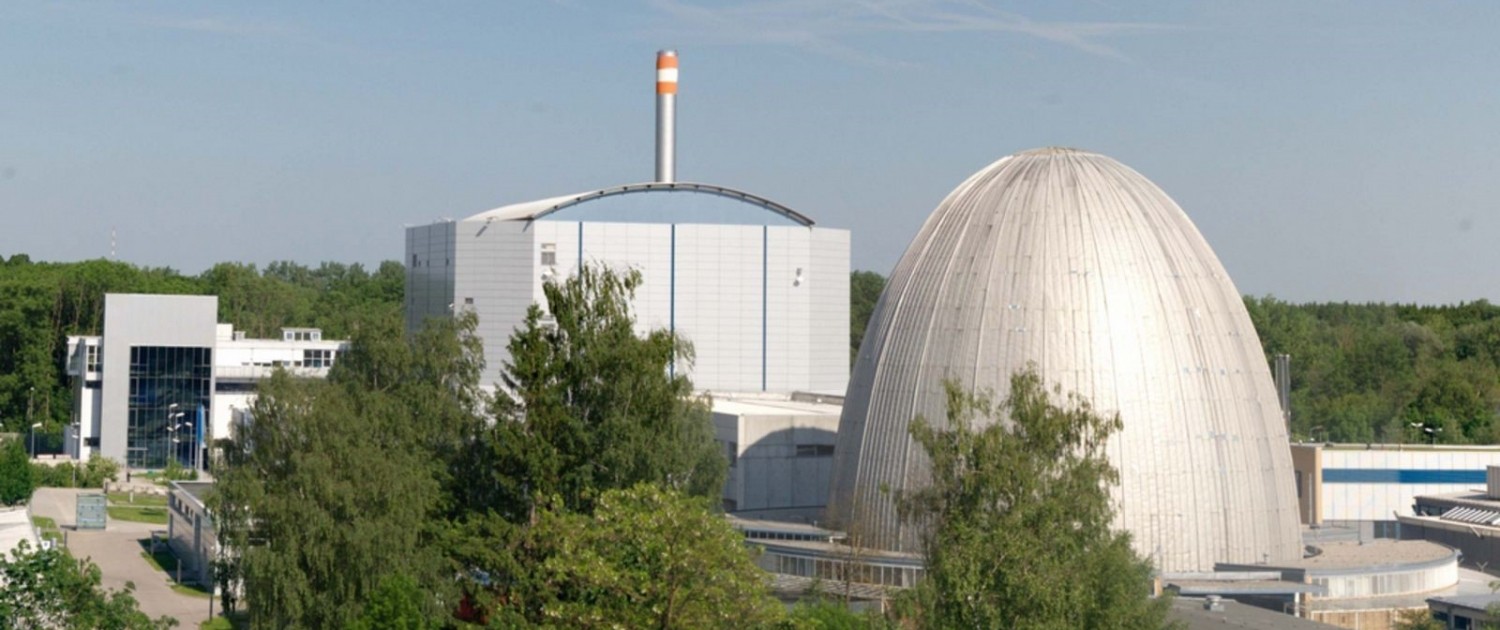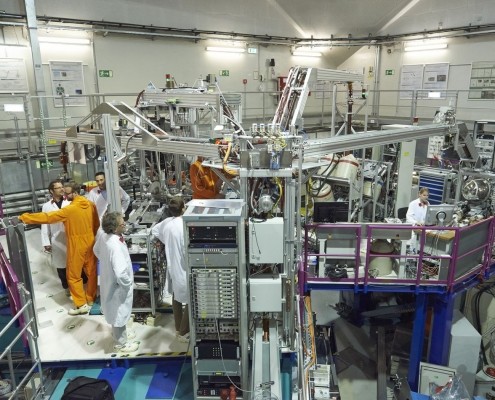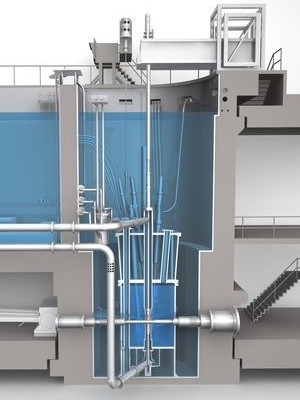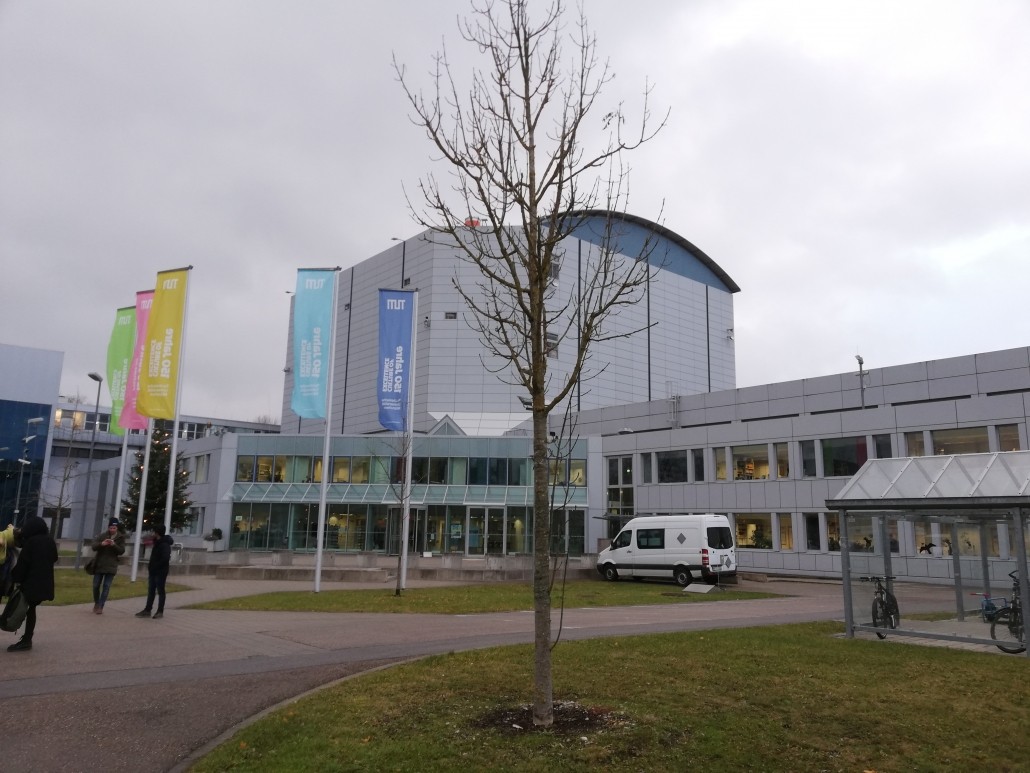(Photo: W. Schürmann, Website FRM II)
A Tour inside TUM’s Research Reactor
by Lyubomir Hristov
The Atom-Ei reactor stood atop a table in the waiting room. The model’s height reached just below my head; its smooth walls rose up like a big metal egg. Through a cut-out in its chrome shell tiny sinks and pipes were visible on the inner wall and right in the centre sat a representation of the reactor core. An array of rods was delicately arranged inside a water-pool, where the tiniest of chain reactions might occur.
Outside, the real Atom-Ei had been emptied long ago, in other words it had undergone an “Entkernen”. Now it stands as a hollow historical landmark of the Atomic Age. After 2000 all operations there were halted (it had worked for 43 years as Germany’s first research reactor) and a successor, the modern FRM II (Forschungs-Neutronenquelle Heinz Maier-Leibnitz, named after the physicist behind the idea of the Atom-Ei) took its place right beside it. This would be the location of our tour.
Model of the Atom-Ei (Photo: L. Hristov)
Prof. Heinz Maier-Leibnitz (Photo: Website FRM II)
Inside the lobby of the reactor building we were told to put on rubber shoe-covers and were joined by our guides, wearing standard white lab coats, who instructed us on the basics. The atmosphere was somehow friendly and open, it seemed like a small lab where even the security personnel were attentive and considerate. We were split into two groups and one person in each had to carry a dosimeter with them, a device that measures the dosage of radiation (in micro Sieverts) received by the wearer. I opted to take one out of curiosity. It had the weight and size of a small pager on my belt (except that it was good at receiving radiation rather than messages). By the end of the tour its reading hadn’t changed from 0 µSv, compared with 10 µSv – the accumulated normal daily dose for an average person.
The goal of the FRM II in Garching is to produce neutrons, the more the better, which are used in research run by different institutes within what is called the experimental hall. To enter this area of the facility, we had to go through a couple of large pressure doors. The inside of the experimental area, our guide explained, was an area of negative pressure. The air pressure was lower inside than the outside, a sort of containment that essentially stopped contaminated particles from being carried outside by a waft of air. Even in a nuclear reactor used solely for research purposes, there is always a chance of contamination.
View of the positron source instruments (Photo: W. Schürmann, Website FRM II)
The research chamber, which formed an upside-down U-shape from our perspective, was large yet crowded with scientific instruments, some concrete walls for shielding and big metal tubes, there was barely enough space to stretch your arms safely without worrying about unplugging a wire or pushing something. Our first stop was ANTARES (Advanced Neutron Tomography And Radiography Experimental System), a neutron imaging project, also called radiography. Basically, it takes images in the same way an X-ray does, except that the picture doesn’t depend on the density of the material being imaged. Thanks to information posters on the walls outside, the project’s impact was made immediately obvious to us; imaging of the inside of a car engine, a mineralized fossil, and an unopenable archaeological specimen, all had been “opened” by neutrons.
We stepped inside for a quick peak at the “camera” of this project. Neutron guides (square tubes completely covered by mirrors on the inside) channel the neutrons directly from the nuclear reactor to the chamber with the specimen to be imaged. Behind the neutron beam and specimen is a recording device, and that’s how you get your image.
Because of the contamination risk in the experimental hall, immediately after exiting it each one of us had to undergo a quick check-up. This involved stepping onto what’s called a Contamination detector machine for the procedure.
The Reactor Basin (Photo: W. Schürmann, Website FRM II)
Because one cannot possibly discern radioactivity using human senses, one must rely on machines or expertise to know where danger lies. We shared a couple of laughs about the odd-looking machine and the accompanying odd-looking procedure, but inside we grimly knew of the potential invisible danger carried by an insignificant particle of dust, and that, no matter how low the radiation, the machine would gladly announce its finding to everyone with an alarm.
It was my turn, so as instructed I inserted my hands into two square holes on the sides, at the end of which were buttons. I was to keep these pressed, let’s say for a minute or so, during which time the machine would detect any radioactive particles on my hands and feet. Eventually an unsatisfied hum let me step down.
Now we hurried on to see the thing we really came here for, the reactor itself. Due to security concerns there was no stepping anywhere near it, but we could take a look from an observation room a couple of floors up. The elevator taking us there was small and inside one couldn’t avoid looking at the oddly labelled buttons. And, in contradiction to the rules of numbering schemes in elevators everywhere our guide pressed “17.2”. Since this was an “abnormal” building with a height of about 30 meters, I assumed the numbers simply represented the height of each storey above ground level.
Cutout of the reactor pool (Image: FRM II/TUM)
The Reactor Basin (Photo: Website FRM II)
You really had to press yourself against the window to see it, but down below was the reactor. Its pool was empty, and a monitor on the other side of the hall read 0.0MW, meaning no power output. It was undergoing maintenance and thus the water had been pumped out. Still full of water, however, was the neighbouring storage pool, and with good reason; this is where all the spent fuel elements would safely reside for years, still highly radioactive. The reactor only uses one at a time.
On a whiteboard behind us, the guide gave us a quick crash course. The workings of the whole process came down to one cylindrical fuel element, a model of which was exhibited in the building’s lobby, where due to its similarity with a simple metal tube it had failed to catch our attention. Within the walls of the tube were hundreds of tiny platelets, made of an alloy containing uranium, which was enriched enough to create a reaction (criticality), but not enough to be useful for anything dangerous. The reactor also possessed enough control rods, which could automatically insert themselves inside the cylindrical fuel element, to halt the reaction.
Then we had a few moments to watch the reactor chamber before leaving. Despite knowing all these things, the experts of the field still had to wield an exotic natural power released hiddenly from our human senses. It involves some bravery, and a great certainty of one’s knowledge of the laws of physics, to handle such energy safely.
(Photo: L. Hristov)
Many thanks to the institute of the FRM II for letting us use their photos!










